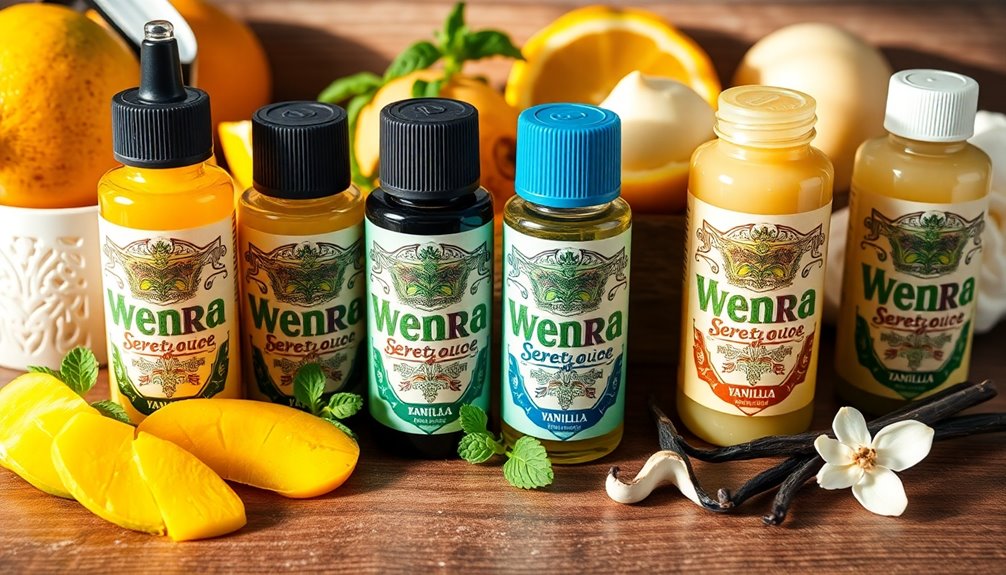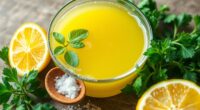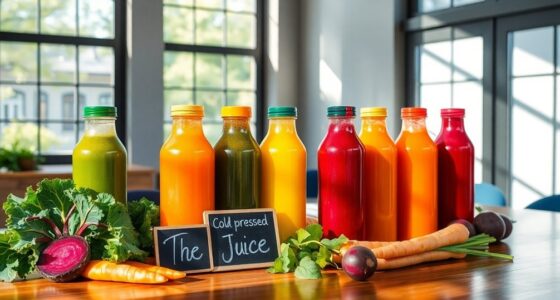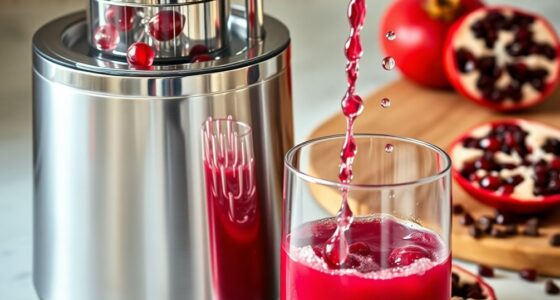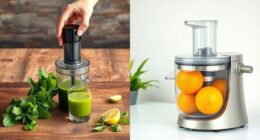To flavor vape juice, start by selecting food-grade flavor concentrates, keeping them around 10-20% of your total liquid volume. Use precise measurements and a recipe calculator for accurate mixing. Blend propylene glycol (PG) and vegetable glycerin (VG) for the right texture. After mixing, steep your e-liquid for several days to let the flavors mature, and remember to follow safety precautions. There’s more to explore about experimenting with flavors and perfecting your recipes! Experimenting with different flavor combinations can lead to unique and personalized vape experiences. Don’t hesitate to adjust the proportions of PG and VG based on your desired throat hit and vapor production. By understanding how to create vape juice, you can unleash your creativity and develop signature blends that cater to your taste preferences. Always keep notes on your recipes to replicate your favorites or refine them further!
Key Takeaways
- Select food-grade flavor concentrates, using 10-20% of total e-liquid volume for optimal flavor intensity.
- Measure ingredients accurately and use a recipe calculator to determine flavoring amounts.
- Balance PG and VG for desired throat hit and vapor texture; PG enhances flavor while VG provides smoothness.
- Allow e-liquid to steep for several days, shaking periodically for even flavor distribution and maturation.
- Experiment with different combinations and track recipes to personalize and recreate favorite vape juice blends.
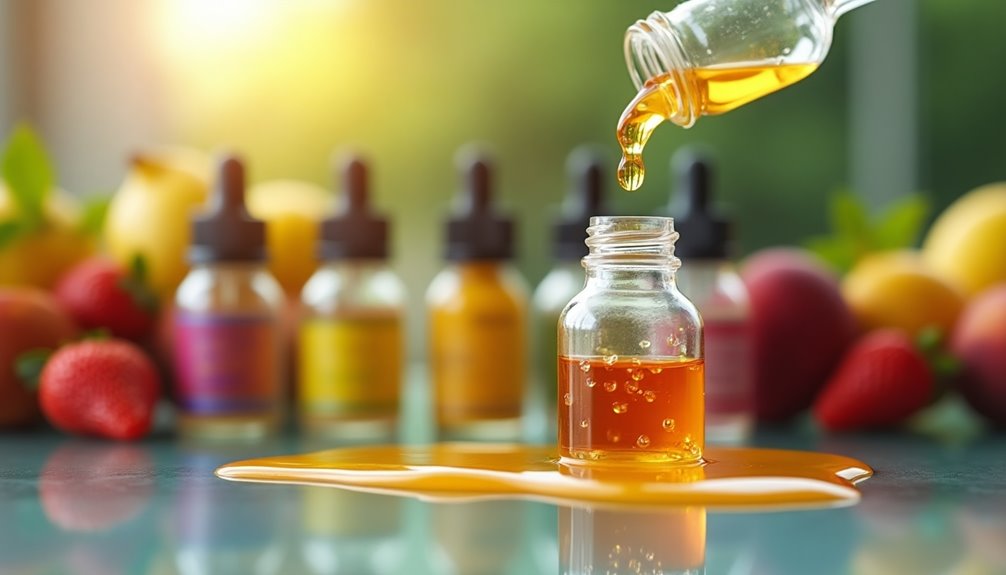
If you want to enhance your vaping experience, flavoring your vape juice can make a significant difference. The process of creating your own custom vape juice allows you to explore a range of flavors and tailor them to your preferences. To get started, you'll need to select food-grade flavour concentrates, which are essential for achieving that rich, enjoyable taste. These concentrates typically make up about 10-20% of the total e-liquid volume, so it's crucial to find the right balance for optimal flavor intensity.
When it comes to mixing your vape juice, using an accurate measurement is key. A precise recipe calculator can help you determine how much flavoring you'll need based on your desired percentage. For example, if you're aiming for a 3% concentration in a 30ml bottle, you'll require 1.2ml of the flavour concentrate. It's always best to start with single flavor mixes. This way, you can understand how each concentrate interacts on its own before diving into more complex flavour profiles.
You'll also want to consider the base of your e-liquid. Most DIY vapers use a combination of PG (propylene glycol) and VG (vegetable glycerin) to create their vape juice. PG is known for carrying flavor well and providing a throat hit, while VG offers a smoother experience and produces thicker vapor. Balancing these two components along with your flavour concentrates is vital for achieving the perfect blend.
After mixing your vape juice, you'll find that steeping it can enhance the overall flavor. Steeping involves letting your e-liquid sit for several days to allow the flavors to mature and blend more effectively. This is especially true for creamy or dessert flavors, which tend to develop better over time. Make sure to shake your mixture periodically during the steeping process to help distribute the flavors evenly.
Safety is important when mixing your vape juice as well. Always work in a clean environment, and store your finished liquids in child-proof containers. Keeping your flavored e-liquids in a cool, dark place will help preserve their quality over time. Additionally, take note of the nicotine strengths you wish to achieve. If you're adding nicotine, carefully measure it out to ensure you reach the desired nicotine content without compromising the balance of your flavoring.
As you embark on this DIY journey, don't be afraid to experiment. Mixing different flavour concentrates can lead to delightful surprises, but remember to keep track of your recipes. This way, you can recreate your favorite blends or make adjustments for future batches. Enjoy the process, and soon enough, you'll be savoring your personalized vape juice, tailored just to your liking. Happy mixing!
Frequently Asked Questions
How Do You Add Flavor to Vape Juice?
To add flavor to vape juice, start by choosing high-quality, food-grade flavor concentrates.
Measure them accurately, aiming for about 10-20% of your total liquid volume.
Mix these concentrates with your base ingredients, propylene glycol and vegetable glycerin, for a balanced blend.
Shake your mixture well to ensure everything's combined, and consider letting it steep for a few days to develop the flavor.
Don't forget to label your creations for consistency!
How Do You Put Flavor in a Vape?
To put flavor in a vape, you start by selecting food-grade flavor concentrates specifically made for vaping.
Measure the desired amount using a recipe calculator—aim for about 10-20% of your total liquid volume.
Mix it thoroughly, and consider starting with single flavors to grasp their impact.
After mixing, let your vape juice steep for a while to enhance the flavor profile.
Enjoy experimenting and finding the perfect blend that suits your taste!
How Do I Make My Vape More Flavorful?
Imagine your vape as a palette, waiting for vibrant colors to dance across its surface.
To make your vape more flavorful, start by adding flavor concentrates, aiming for a 10-20% mix.
Don't shy away from blending flavors, like a painter mixing shades.
Let your creation steep for at least five days to deepen the taste.
Lastly, shake it well to ensure everything's combined, and you'll soon enjoy a masterpiece of flavor in every puff.
What Is Used to Flavor Vape Juice?
To flavor vape juice, you'll primarily use food-grade flavor concentrates.
These concentrates come in a variety of options, like fruits, candies, and desserts. Popular brands, such as LorAnn and The Flavor Apprentice, offer numerous choices for your DIY mixes.
Generally, you'll want to use about 10-20% of these concentrates in your blend.
Just make sure to avoid flavored oils not meant for consumption, as they can be harmful when vaporized.
Conclusion
Now that you know how to flavor vape juice, imagine transforming a bland cloud into a burst of your favorite fruit or dessert. It's like adding a splash of color to a gray canvas, turning each puff into a delicious experience. Whether it's sweet, savory, or something uniquely you, the right flavors can elevate your vaping journey. So, go ahead and experiment—your perfect blend is just a few drops away, waiting to dance on your taste buds!
Cindy thoroughly researches juicing trends, techniques, and recipes to provide readers with practical advice and inspiration. Her writing style is accessible, engaging, and designed to make complex concepts easy to understand. Cindy’s dedication to promoting the advantages of juicing shines through her work, empowering readers to make positive changes in their lives through the simple act of juicing.

